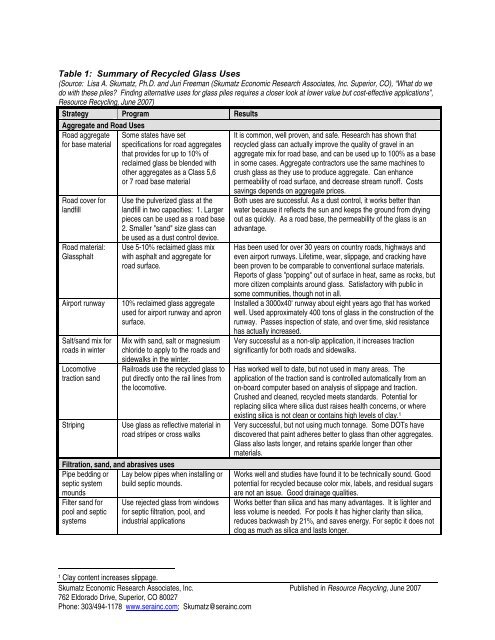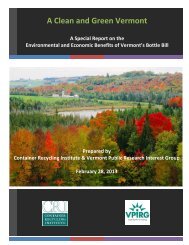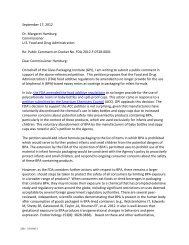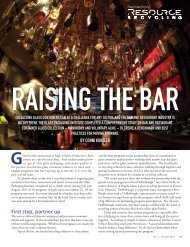Create successful ePaper yourself
Turn your PDF publications into a flip-book with our unique Google optimized e-Paper software.
<strong>Table</strong> 1: <strong>Summary</strong> <strong>of</strong> <strong>Recycled</strong> <strong>Glass</strong> <strong>Uses</strong><br />
(Source: Lisa A. Skumatz, Ph.D. and Juri Freeman (Skumatz Economic Research Associates, Inc. Superior, CO), “What do we<br />
do with these piles? Finding alternative uses for glass piles requires a closer look at lower value but cost-effective applications”,<br />
Resource Recycling, June 2007)<br />
Strategy Program Results<br />
Aggregate and Road <strong>Uses</strong><br />
Road aggregate<br />
for base material<br />
Road cover for<br />
landfill<br />
Road material:<br />
<strong>Glass</strong>phalt<br />
Some states have set<br />
specifications for road aggregates<br />
that provides for up to 10% <strong>of</strong><br />
reclaimed glass be blended with<br />
other aggregates as a Class 5,6<br />
or 7 road base material<br />
Use the pulverized glass at the<br />
landfill in two capacities: 1. Larger<br />
pieces can be used as a road base<br />
2. Smaller "sand" size glass can<br />
be used as a dust control device.<br />
Use 5-10% reclaimed glass mix<br />
with asphalt and aggregate for<br />
road surface.<br />
Airport runway 10% reclaimed glass aggregate<br />
used for airport runway and apron<br />
surface.<br />
Salt/sand mix for<br />
roads in winter<br />
Locomotive<br />
traction sand<br />
Mix with sand, salt or magnesium<br />
chloride to apply to the roads and<br />
sidewalks in the winter.<br />
Railroads use the recycled glass to<br />
put directly onto the rail lines from<br />
the locomotive.<br />
Striping Use glass as reflective material in<br />
road stripes or cross walks<br />
Filtration, sand, and abrasives uses<br />
Pipe bedding or<br />
septic system<br />
mounds<br />
Filter sand for<br />
pool and septic<br />
systems<br />
Lay below pipes when installing or<br />
build septic mounds.<br />
Use rejected glass from windows<br />
for septic filtration, pool, and<br />
industrial applications<br />
It is common, well proven, and safe. Research has shown that<br />
recycled glass can actually improve the quality <strong>of</strong> gravel in an<br />
aggregate mix for road base, and can be used up to 100% as a base<br />
in some cases. Aggregate contractors use the same machines to<br />
crush glass as they use to produce aggregate. Can enhance<br />
permeability <strong>of</strong> road surface, and decrease stream run<strong>of</strong>f. Costs<br />
savings depends on aggregate prices.<br />
Both uses are successful. As a dust control, it works better than<br />
water because it reflects the sun and keeps the ground from drying<br />
out as quickly. As a road base, the permeability <strong>of</strong> the glass is an<br />
advantage.<br />
Has been used for over 30 years on country roads, highways and<br />
even airport runways. Lifetime, wear, slippage, and cracking have<br />
been proven to be comparable to conventional surface materials.<br />
Reports <strong>of</strong> glass "popping" out <strong>of</strong> surface in heat, same as rocks, but<br />
more citizen complaints around glass. Satisfactory with public in<br />
some communities, though not in all.<br />
Installed a 3000x40' runway about eight years ago that has worked<br />
well. Used approximately 400 tons <strong>of</strong> glass in the construction <strong>of</strong> the<br />
runway. Passes inspection <strong>of</strong> state, and over time, skid resistance<br />
has actually increased.<br />
Very successful as a non-slip application, it increases traction<br />
significantly for both roads and sidewalks.<br />
Has worked well to date, but not used in many areas. The<br />
application <strong>of</strong> the traction sand is controlled automatically from an<br />
on-board computer based on analysis <strong>of</strong> slippage and traction.<br />
Crushed and cleaned, recycled meets standards. Potential for<br />
replacing silica where silica dust raises health concerns, or where<br />
existing silica is not clean or contains high levels <strong>of</strong> clay. 1<br />
Very successful, but not using much tonnage. Some DOTs have<br />
discovered that paint adheres better to glass than other aggregates.<br />
<strong>Glass</strong> also lasts longer, and retains sparkle longer than other<br />
materials.<br />
Works well and studies have found it to be technically sound. Good<br />
potential for recycled because color mix, labels, and residual sugars<br />
are not an issue. Good drainage qualities.<br />
Works better than silica and has many advantages. It is lighter and<br />
less volume is needed. For pools it has higher clarity than silica,<br />
reduces backwash by 21%, and saves energy. For septic it does not<br />
clog as much as silica and lasts longer.<br />
1 Clay content increases slippage.<br />
Skumatz Economic Research Associates, Inc. Published in Resource Recycling, June 2007<br />
762 Eldorado Drive, Superior, CO 80027<br />
Phone: 303/494-1178 www.serainc.com; Skumatz@serainc.com
Strategy Program Results<br />
Sand for<br />
beaches, golf<br />
courses, or<br />
playgrounds<br />
Industrial<br />
abrasives<br />
Pulverize sand to a small enough<br />
grain to be used on a golf course<br />
or playground<br />
Use recycled glass as an abrasive<br />
for cleaning, scouring, and blasting<br />
<strong>of</strong> various surface types.<br />
Landscaping, Tiles, and other uses<br />
Landscaping Give away glass as a landscaping<br />
material for free at landfill.<br />
Preliminary testing on beaches and golf courses has shown the<br />
potential <strong>of</strong> this use. Public perception and cost are issues. (see<br />
“Beached glass” in the February 2007 issue <strong>of</strong> Resource Recycling)<br />
A very successful use for recycled glass. <strong>Glass</strong> as an abrasive has<br />
proven advantages. 2<br />
Some communities reported liking the way it looks, while others did<br />
not. Some (fermented alcohol) odor issues if not washed.<br />
Trail bed Cover trails in glass sand. Generally, hikers have not liked the look <strong>of</strong> the trails. Also, the glass<br />
must be repeatedly screened to remove all labels and contamination.<br />
Has worked well in national park that had trail drainage issues.<br />
Compost Mixed crushed glass with compost. Mixed success. Reports that glass would make its way to the bottom<br />
<strong>of</strong> the pile and it was also "sparkly". Can improve the drainable<br />
quality in areas with poor soils; some areas already have "sparkly"<br />
<strong>Glass</strong>-epoxy<br />
flooring<br />
Sell pulverized glass to flooring<br />
company for seamless flooring or<br />
counter tops.<br />
Kiln process Integrates recycled glass into<br />
conventional ceramic processes to<br />
make tiles and countertops<br />
soil.<br />
Can be potentially very successful. Limiting factors include: 1) the<br />
distance to a manufacturing plant 2) consistent quality and color <strong>of</strong><br />
collected materials. Life cycle in use as floor covering is strong.<br />
Quite expensive process for not a lot <strong>of</strong> glass tonnage but very nice<br />
high end artisan product. Some technologies being patented. 3<br />
About the Authors: Dr. Lisa A. Skumatz, an economist, is Principal <strong>of</strong> the research and consulting firm Skumatz Economic Research<br />
Associates, Inc. (SERA); Mr. Freeman is a project manager at SERA. SERA (www.serainc.com) specializes in economic and policy analysis <strong>of</strong><br />
solid-waste management, especially program evaluation and cost-effectiveness, rate studies, incentives, integrated planning, and<br />
modeling/forecasting. SERA has worked with community, state, and federal solid waste clients across the US, Canada, and overseas, and has<br />
more than six dozen publications on solid-waste and resource economics. SERA maintains <strong>of</strong>fices in Boulder, Colorado and Washington<br />
State. Contact information: 303/494-1178, Skumatz@serainc.com.<br />
2 Additional information from interviews and research on this use follows. Interviews / research indicated glass is angular and<br />
can cut sub-coatings well. The "white metal" finish is reported to be superior to other abrasives. There may be potential for<br />
lower dust generation. The material may be reused, is less dense, and produces more volume per ton. Also recycled glass has<br />
none <strong>of</strong> the heavy metals <strong>of</strong> smelter-derived abrasives. Most currently use rejected and recycled window glass rather than<br />
curbside because screening and cleaning needed to avoid clogging sprayer lines. Economics need improvement in areas where<br />
alternatives are inexpensive / readily available.<br />
3 This application shows considerable promise, and tonnage use may have greater potential than initially indicated.<br />
Skumatz Economic Research Associates, Inc. Published in Resource Recycling, June 2007<br />
762 Eldorado Drive, Superior, CO 80027<br />
Phone: 303/494-1178 www.serainc.com; Skumatz@serainc.com






